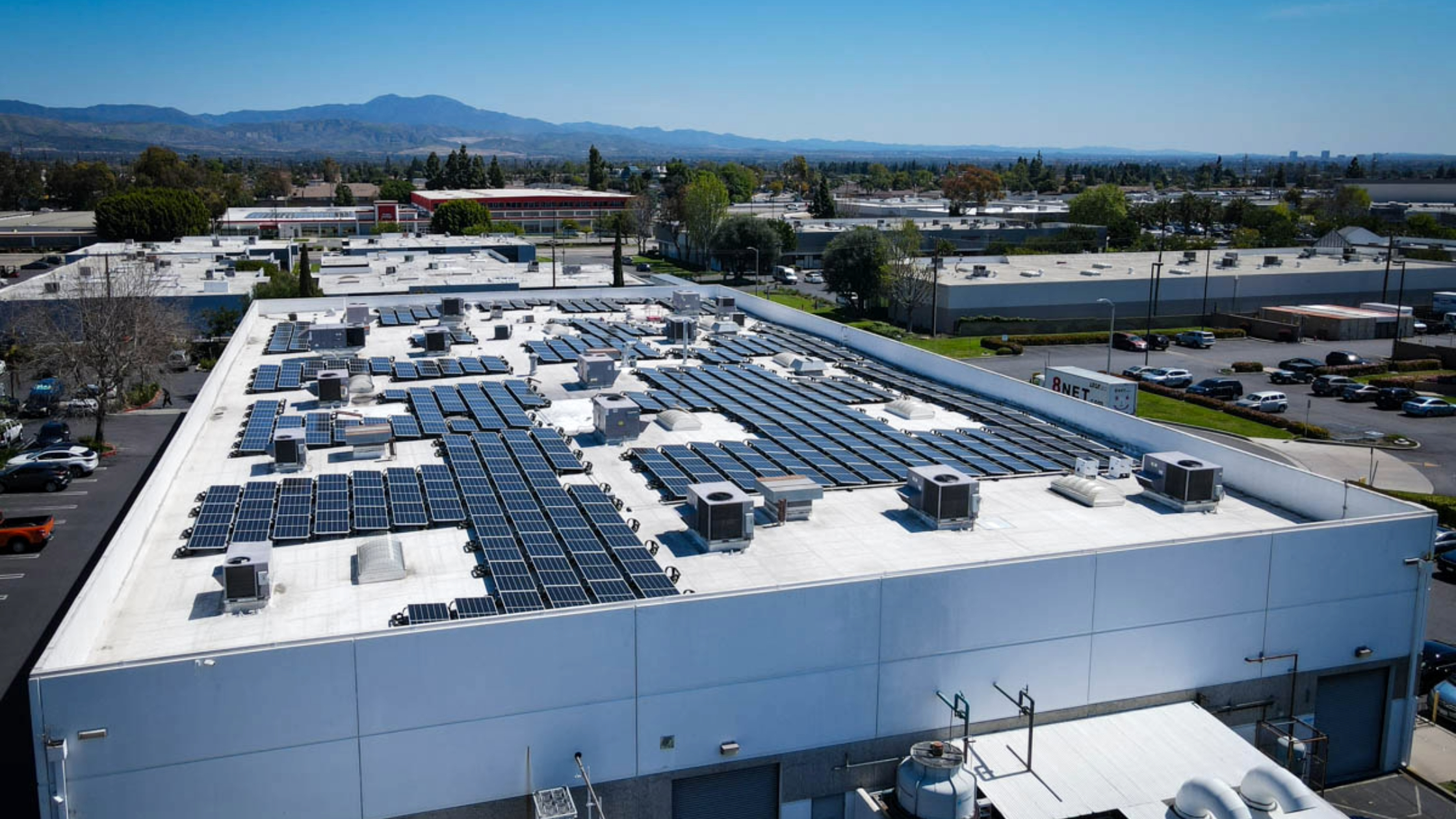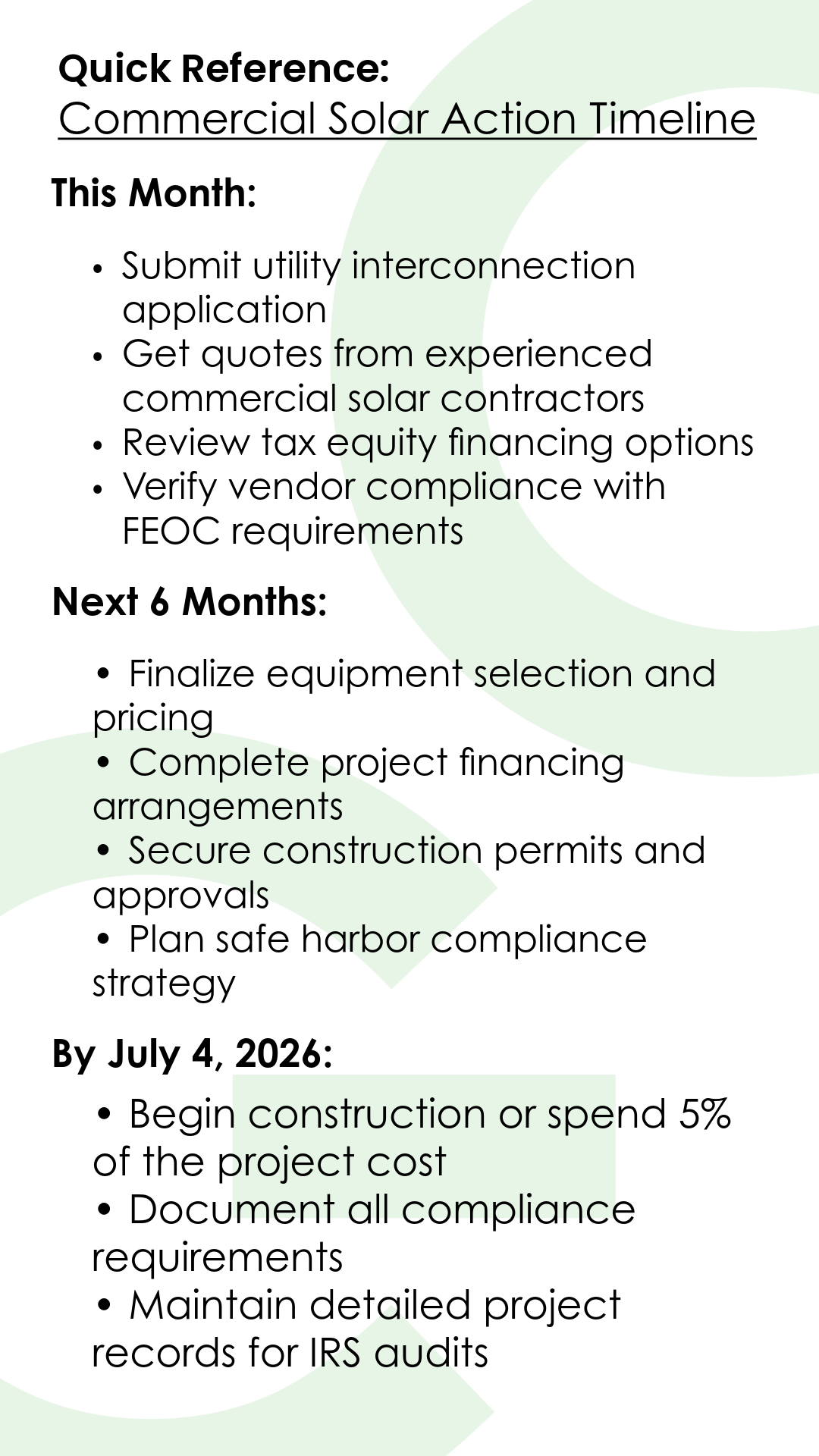Commercial Solar Tax Credit Changes 2025: What Business Owners Need to Know

TL;DR: The One Big Beautiful Bill passed in July 2025 keeping the 30% commercial solar tax credit but adds a hard deadline. Businesses must start construction by July 4, 2026 to claim full benefits. Early action is critical to avoid supply chain delays and secure tax credits.
Your energy bills aren't getting any cheaper, and if you're running a business or managing properties, solar has probably crossed your mind more than once. Here's what just happened that affects every commercial solar decision: the One Big Beautiful Bill (OBBB) or HR1 passed in July and has created a window of opportunity for businesses — but it comes with a deadline you can't ignore.
What Changed with the Commercial Solar Tax Credit in 2025?
Let's cut through the policy jargon. The Investment Tax Credit — that's the 30% federal tax break for commercial solar — is still there. But HR1 added a hard deadline: you need to start construction by July 4, 2026, to claim the credit.
"Start construction" doesn't mean you need to have solar panels on your roof by then. It means you either need to begin physical work or spend 5% of your project's total cost by that date. For most businesses, hitting that 5% threshold is pretty doable — it could be equipment purchases, engineering work, or other project expenses.
Here's where it gets interesting: if you start construction BEFORE July 2026, you get what's called "safe harbor" protection. That means you have up to four years to finish your project while still claiming the full tax credit. AFTER that July deadline, though, and you're racing against the clock to have your system up and running by December 31, 2027.
The legislation also introduced Foreign Entity of Concern (FEOC) restrictions. Without getting too deep into the weeds, this affects which companies can receive tax credit transfers. It's not a deal-breaker, but it does mean you'll want to work with experienced solar partners who understand these new rules.
Here's what nobody's talking about yet: we're about to see a massive rush on solar projects. Think about it — every business that's been considering solar now has the same deadline. That means interconnection applications, equipment orders, and installation schedules are all going to get squeezed into the next 18 months.
We've seen this before. When California changed its net metering rules, interconnection queues that normally took two months started taking six months or more. Readily available equipment suddenly had six-month lead times. Installation crews that were booking projects next month were suddenly booked through the following year.
The businesses that moved early avoided the crunch. The ones that waited ended up paying more, waiting longer, and in some cases, missing out entirely.
What Are the New Supply Chain Requirements for Commercial Solar?
HR1 comes with some supply chain complications you should know about. Equipment suppliers and contractors will need to prove they're not connected to FEOC designations to maintain tax credit eligibility. This isn't necessarily a problem, but it's one more thing to document and verify.
The bigger issue is going to be capacity. Solar installers, equipment manufacturers, and utility interconnection departments aren't staffed for the kind of volume spike we're expecting. We were already seeing this as the legislation was moving through Congress — and now that the One Big Beautiful Bill has passed, when everyone's trying to start their project at the same time, something's got to give — and it's usually timeline and pricing.
How Do You Document Commercial Solar Tax Credit Compliance?
The IRS has extended its audit window for renewable energy tax credits to six years and made it clear they're going to be more thorough about checking compliance. That means documentation isn't just helpful — it's essential.
You'll need to keep detailed records of when you started construction, proof that your vendors meet FEOC requirements, copies of your interconnection applications, and documentation that your financing aligns with tax credit rules. It sounds like a lot — and honestly, it is.
That's where working with Green Convergence makes a real difference. We handle all the compliance documentation for our commercial clients, from maintaining vendor FEOC certifications to organizing construction timeline proof for IRS requirements. You focus on running your business while we make sure your solar project stays compliant and audit-ready. Our clients sleep better knowing their tax credit documentation is bulletproof.
Why Should Businesses Act Now on Solar Projects?
Here's the math that matters: solar equipment costs are relatively stable right now, but that's about to change. As demand spikes toward the July 2026 deadline, expect prices to rise. Installation capacity is going to get tight, which means longer waits and higher labor costs.
But there's good news too. The HR1 bumped up Bonus Depreciation back to 100%, which provides added cost relief. And interconnection applications submitted now will be processed under current timelines, not the extended delays we're expecting next year.
Key benefits of acting now:
- Lock in current equipment pricing before demand drives costs up
- Secure your place in utility interconnection queues
- Avoid the contractor capacity crunch expected in 2026
- Qualify for safe harbor protection with strategic project timing
Time to Make Your Move

The federal government just gave commercial solar customers a clear message: the 30% tax credit is still available, but the window for claiming it is closing. Businesses that act quickly will lock in substantial tax benefits while avoiding the supply chain crunch that's coming.
Here's what you need to do immediately — and how Green Convergence makes it happen:
Start your interconnection application this month.
Even if you're not ready to break ground, getting your place in the utility queue protects you from processing delays that could jeopardize your tax credit eligibility. Green Convergence has been navigating policy changes and supply chain challenges for years.
While other installers are scrambling to understand these new rules, we're already helping our commercial clients secure their place in utility queues. We know which utilities are processing fastest and can get your application submitted right away.
Plan your safe harbor strategy.
If you're planning a large or complex project that might not be finished by July 2026, you need to identify the most efficient way to trigger safe harbor protection. Sometimes that's equipment purchases, sometimes it's engineering work — but you want to plan this strategically. We help our clients structure projects for maximum safe harbor protection, so you maintain tax credit eligibility even with extended timelines.
Ensure FEOC compliance.
Make sure any solar partners you're considering understand FEOC compliance requirements. This isn't just about equipment suppliers — it affects every aspect of your project that touches tax credit eligibility.
We know which vendors meet FEOC requirements and lock in compliant equipment pricing for our clients, so there are no surprises down the road.
Document everything properly.
With extended audit windows and increased IRS scrutiny, thorough record-keeping isn't optional anymore. As we mentioned earlier, Green Convergence handles all the compliance documentation for our commercial clients, from maintaining vendor FEOC certifications to organizing construction timeline proof for IRS requirements.
The opportunity is real, but so is the timeline. We're already seeing smart business owners submit interconnection applications and lock in equipment pricing to protect their projects from the rush that's building.
If you've been thinking about solar for your business, now's the time to get serious about it. The longer you wait, the more expensive and complicated it's going to get — and the harder it'll be to find an installer who isn't already booked solid through 2026.
Commercial Solar Tax Credit FAQ
Q: What exactly is the July 4, 2026 deadline for commercial solar?
A: This is the last date businesses can "begin construction" on solar projects to claim the full 30% federal tax credit. You can meet this by either starting physical work or spending 5% of the project cost. Any project that begins construction past this deadline must be placed into service before Dec. 31, 2027.
Q: How much time do I have to complete my project after starting construction?
A: Projects that begin construction before July 4, 2026 have safe harbor protection, giving you up to four years to complete the installation while maintaining tax credit eligibility.
Q: What are FEOC restrictions and how do they affect commercial solar projects?
A: Foreign Entity of Concern restrictions prevent certain companies from receiving tax credit transfers. This mainly affects vendor selection and requires additional compliance documentation.
Q: Will solar equipment costs increase due to the deadline?
A: Yes, expect price increases as demand spikes toward the July 2026 deadline. Equipment that's readily available now may have extended lead times and higher costs in 2025-2026.
Q: Should I submit an interconnection application even if I'm not ready to install solar?
A: Absolutely. Getting your place in the utility queue now protects you from processing delays that could jeopardize your tax credit eligibility.
RELATED ARTICLES:
Our Affiliations









